Twice-cooked pork adobo is hands down the best way to cook adobo. This not-so-secret method not only locks in the flavor but also makes a rich, glossy, and slightly thick sauce. Everything you love about Filipino adobo is here!
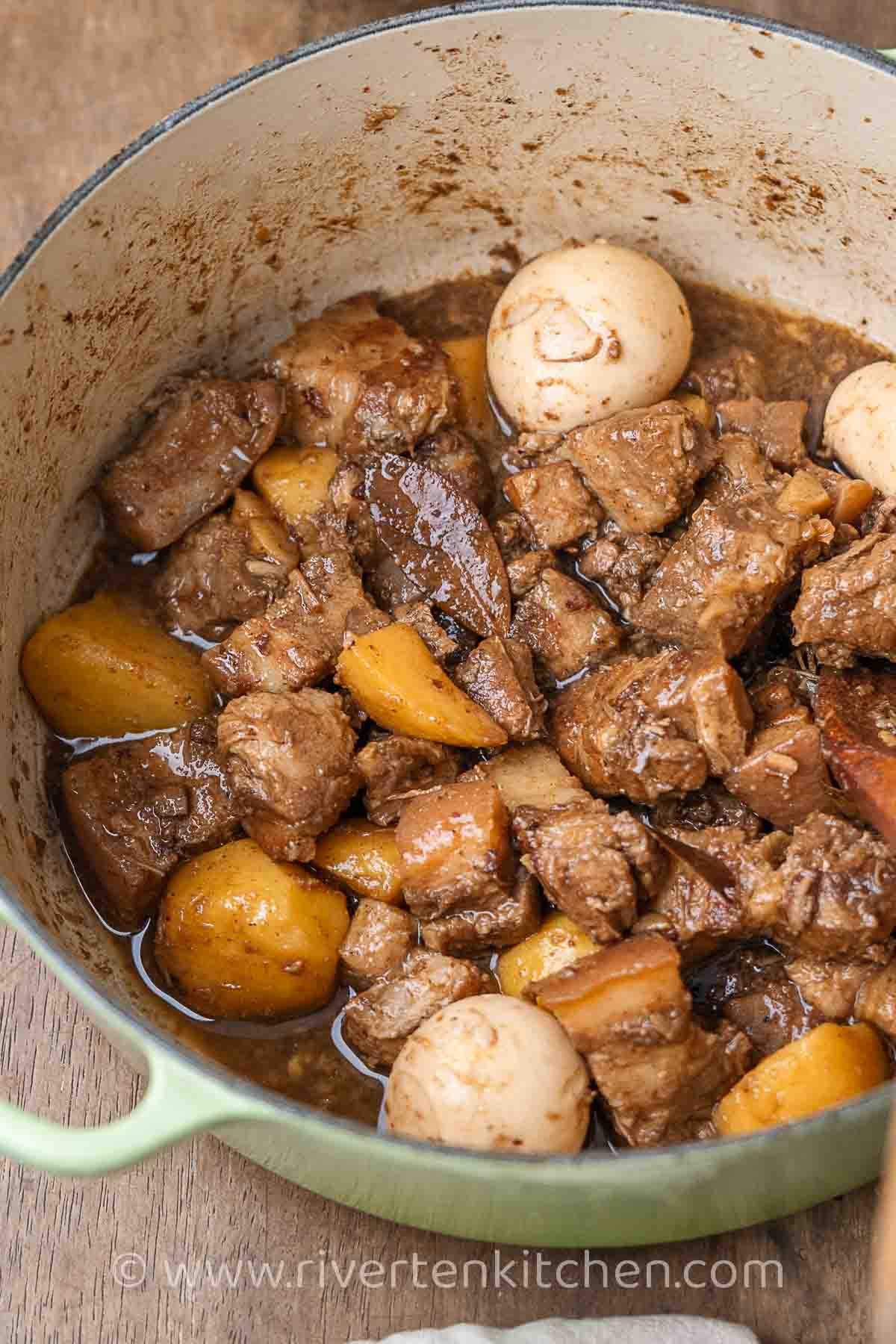
What is Adobo?
The term adobo originated from the Spanish word “adobar” which means seasoning of food in spices and various condiments. In the Philippines, it refers to a dish made of meat and or vegetables cooked in soy sauce, vinegar, and garlic. Some say it’s a stew, while others say it’s a braised dish. Well, I just call it adobo.
Let’s cook, shall we?
Why cook pork adobo twice?
Adobo is one of those dishes that taste better the next day. Every adobo lover knows this for a fact. But, why wait for tomorrow? Here, you will learn how to give your adobo that delicious second-day flavor.
The technique is called the “twice-cook technique”. I admit, at first, I found the method to be cumbersome. But after many, many years of making adobo using different recipes and cooking styles, I have to say that this truly is the best way of making adobo.
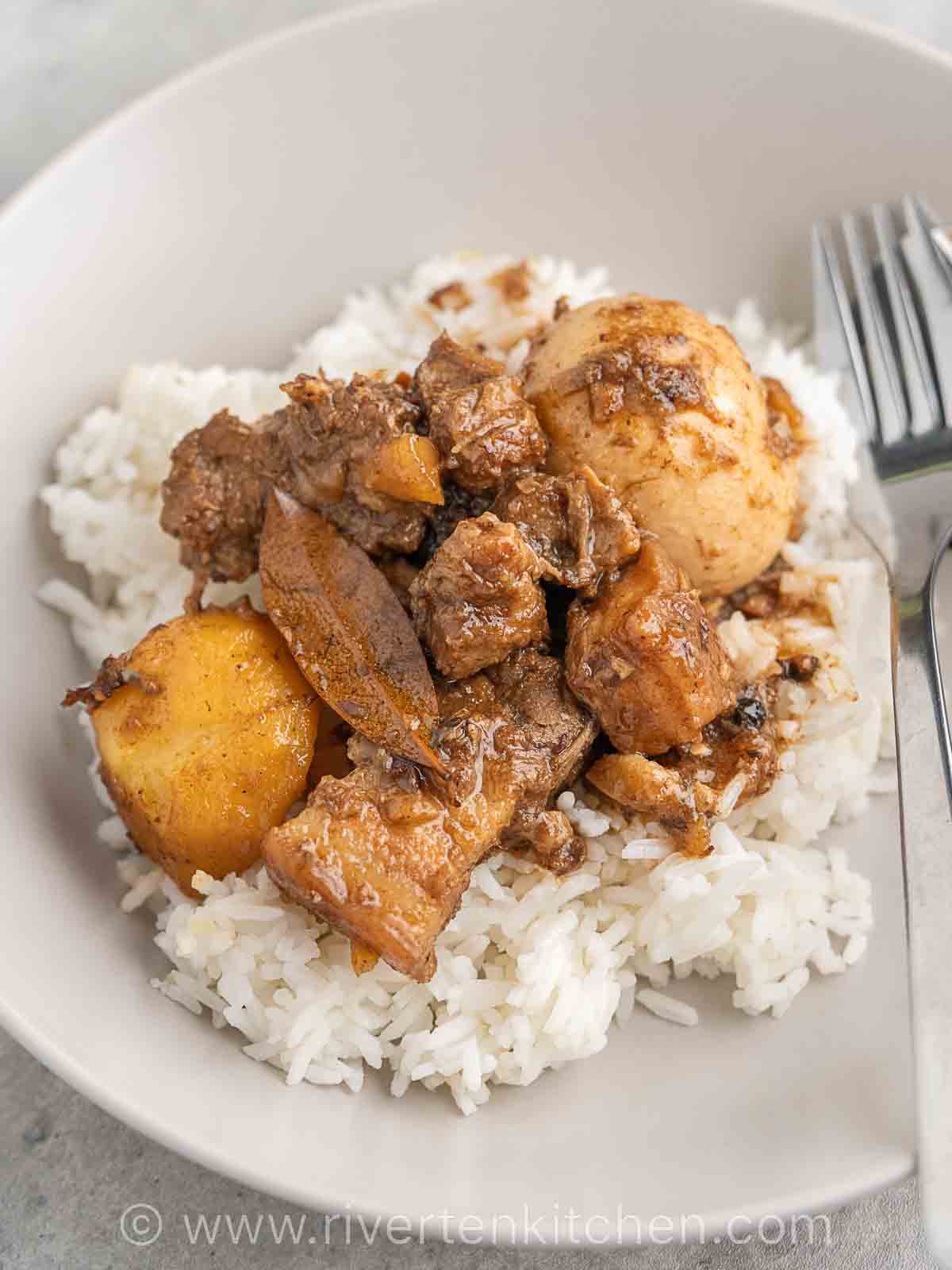
You will love this recipe because:
- It’s a simplified version of a twice-cooked adobo. This recipe has fewer steps compared to other recipes.
- No marination is needed. Cook it right away. No more waiting!
- The pork is succulently tender. Not dry or tough.
- The sauce is thick, rich, and, glistening with fat–the very definition of a good Filipino pork adobo.
- Flavorful, perfectly balanced adobo sauce–no salty nor too vinegary sauce here.
- You only need one pot–although we’re cooking the adobo two times, we’re using one pot to do both steps.
Ingredients
Here’s what you need to make the best pork adobo at home. Lots of tips included!
Pork
The best cut of pork for adobo is pork belly and pork shoulder or pork butt as the fat makes a richer and more flavorful sauce. I often prefer using a combination of both cuts for a less greasy sauce. Pork ribs and even pork leg/ham can also be used but will of course require a longer cooking time.

Tip: Need to make adobo in less than 1 hour? Slice the pork into small chunks about 1/2 inch. The smaller the cut, the lesser the cooking time.
Adobo Sauce
And here’s what you need to make the adobo sauce:
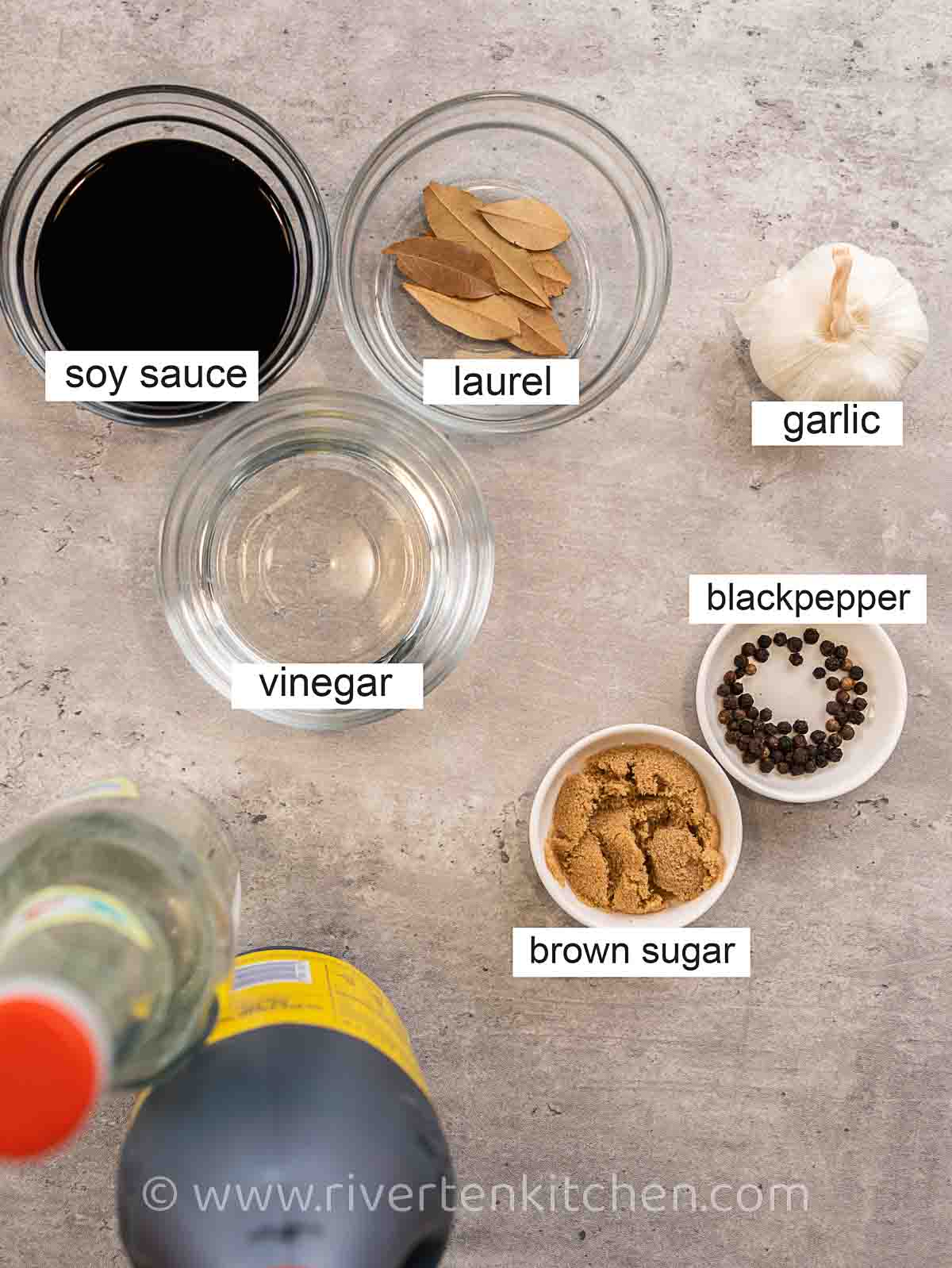
Soy Sauce
I recommend using the classic Filipino soy sauce to get that authentic adobo flavor. It can be substituted with any regular soy sauce but you will need to experiment with the amount because the saltiness does vary.
What I don’t recommend is light soy sauce/ low sodium and premium dark soy sauce. The former doesn’t have enough flavor and color, while the latter is too dark and thick and less salty.
Vinegar
For the vinegar, I love using white rice vinegar (not seasoned). It’s less acidic and mild in flavor. It can be substituted with cane vinegar, coconut vinegar, and apple cider vinegar.
Sukang Iloko is also a favorite of many Ilocanos when making adobo. It is made of sugar cane and has a unique strong acidic scent.
Spices
Garlic, bay leaf (also called laurel leaf), and black peppercorns are what give adobo its signature aroma. Thus, must always be present when making adobo dishes. Onions can be optional but not garlic.
Sugar
I prefer adding a touch of sugar to balance the flavor of the sauce. It sort of mellows down the salt in soy sauce and the acidity of the vinegar.
How to make Twice Cooked Pork Adobo
And here’s how to make it.
1. Tenderize the Pork
Rather than marinating the pork before cooking, we cook the pork right away in the adobo sauce.
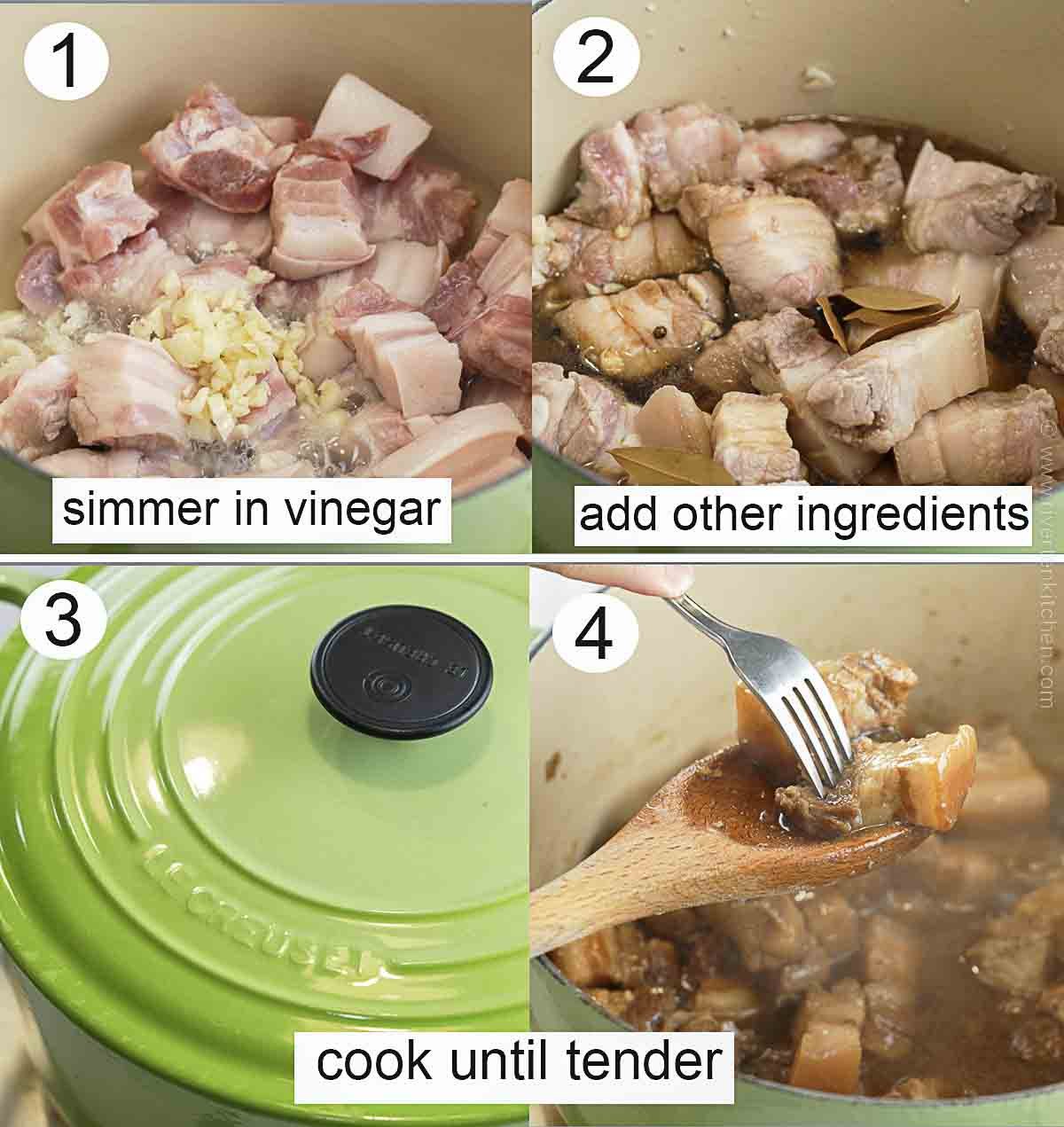
Here are the key steps:
- Start by simmering the pork in vinegar and garlic for a few minutes before adding the rest of the ingredients. This technique helps weaken the protein structure of the meat thus making it easy to absorb all the flavors of the surrounding ingredients.
- Cover with a lid and cook until tender over medium-low heat. Without the lid, the sauce will evaporate too quickly.
- Add water as needed. Having enough liquid will allow you to cook pork until it’s tender. I’ve seen other people add more soy sauce to increase the liquid. DON’T DO IT! It will make the sauce too salty.
2. Fry the pork and thicken the sauce
And now my favorite part. Once the pork is tender, the next part is cooking it again without the sauce.
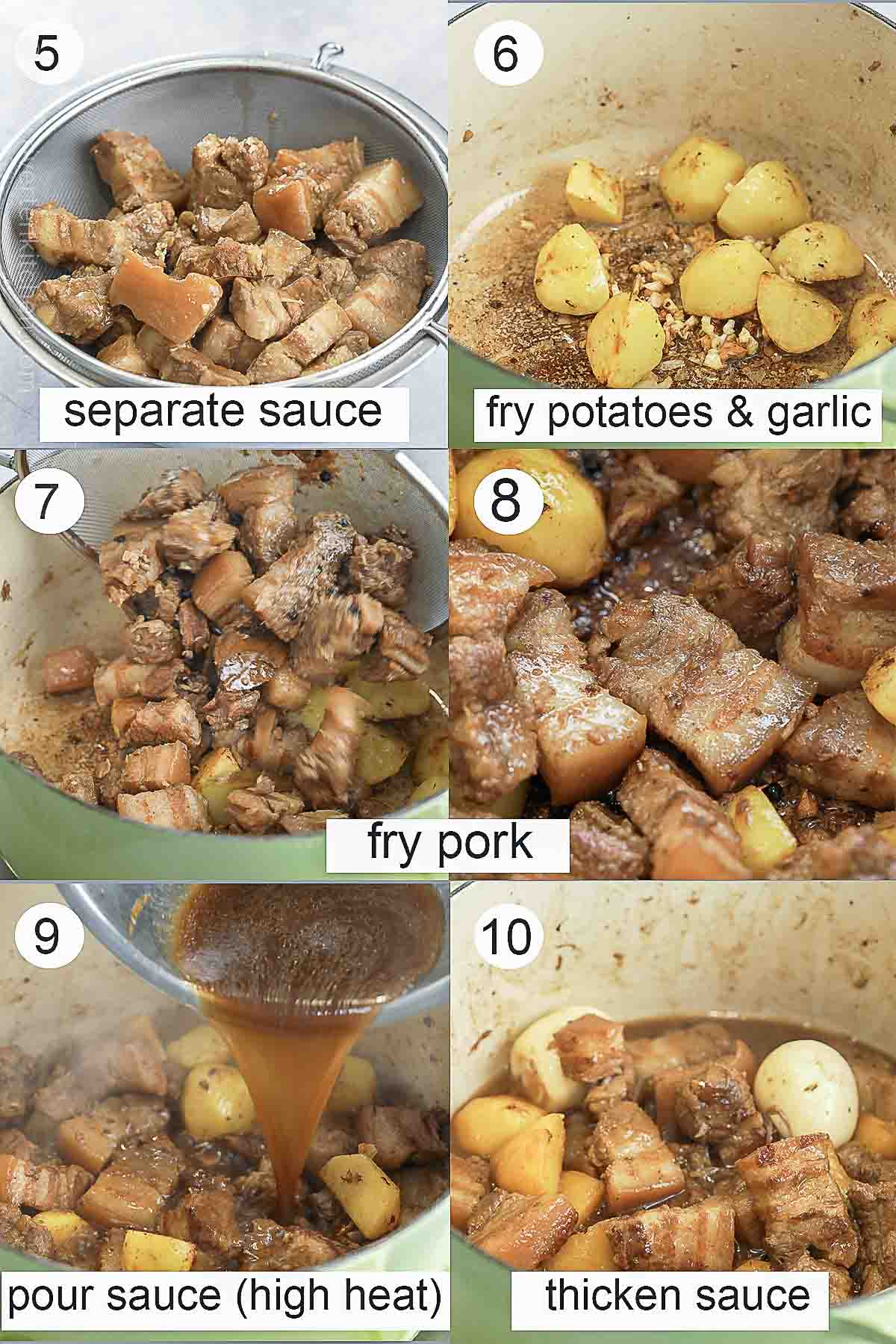
Here are a few tips:
- To easily separate the sauce and meat, you can use a colander or a slotted spoon. I find using the colander to be more practical as it also serves as a container for the pork.
- For a garlicky adobo, toast another batch of garlic in the same pot. to get that beautiful toasted garlic aroma. I do this after frying the potatoes so it doesn’t burn.
- Fry the pork for a few minutes to render the fat. I recommend using two large spoons to easily move them around.
- To quickly thicken the sauce, set the heat to medium-high BEFORE adding it back to the pot. Simmer until desired consistency is achieved!
That is it! EASY. DELICIOUS!
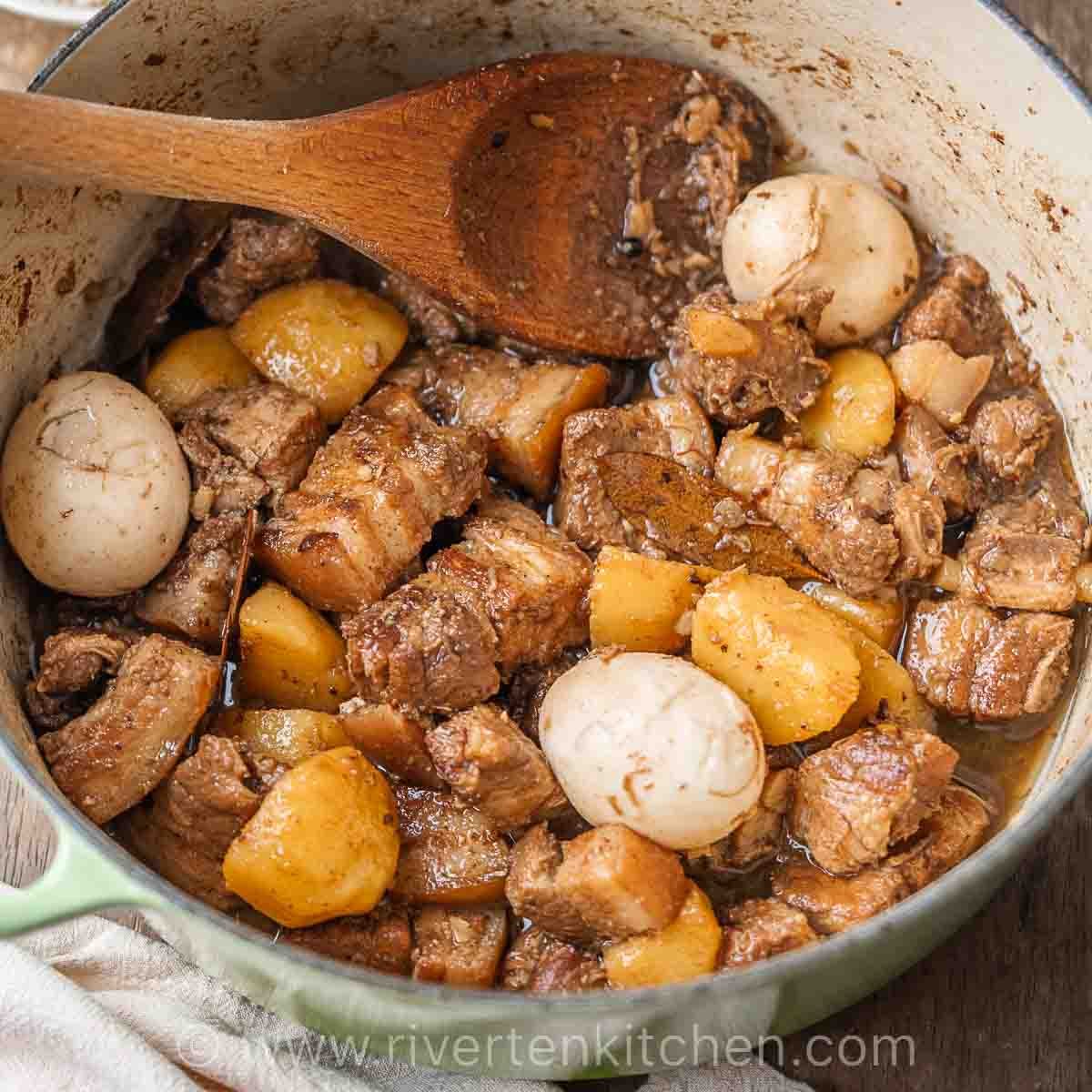
Why add potatoes and eggs?
Adding potatoes and eggs is one of the best ways to make your pork adobo extra special. Plus the starch in the potatoes gives the sauce that extra gloss. Plus, I just love my adobo with eggs, it completes the whole experience for me.
Serve
Adobo is best served with warm rice or garlic-fried rice. I love pairing it with atchara (Filipino pickled papaya).
For vegetables, I like serving adobo with pinakbet, ginataang gulay, stir-fried chayote, and Monggo Guisado.
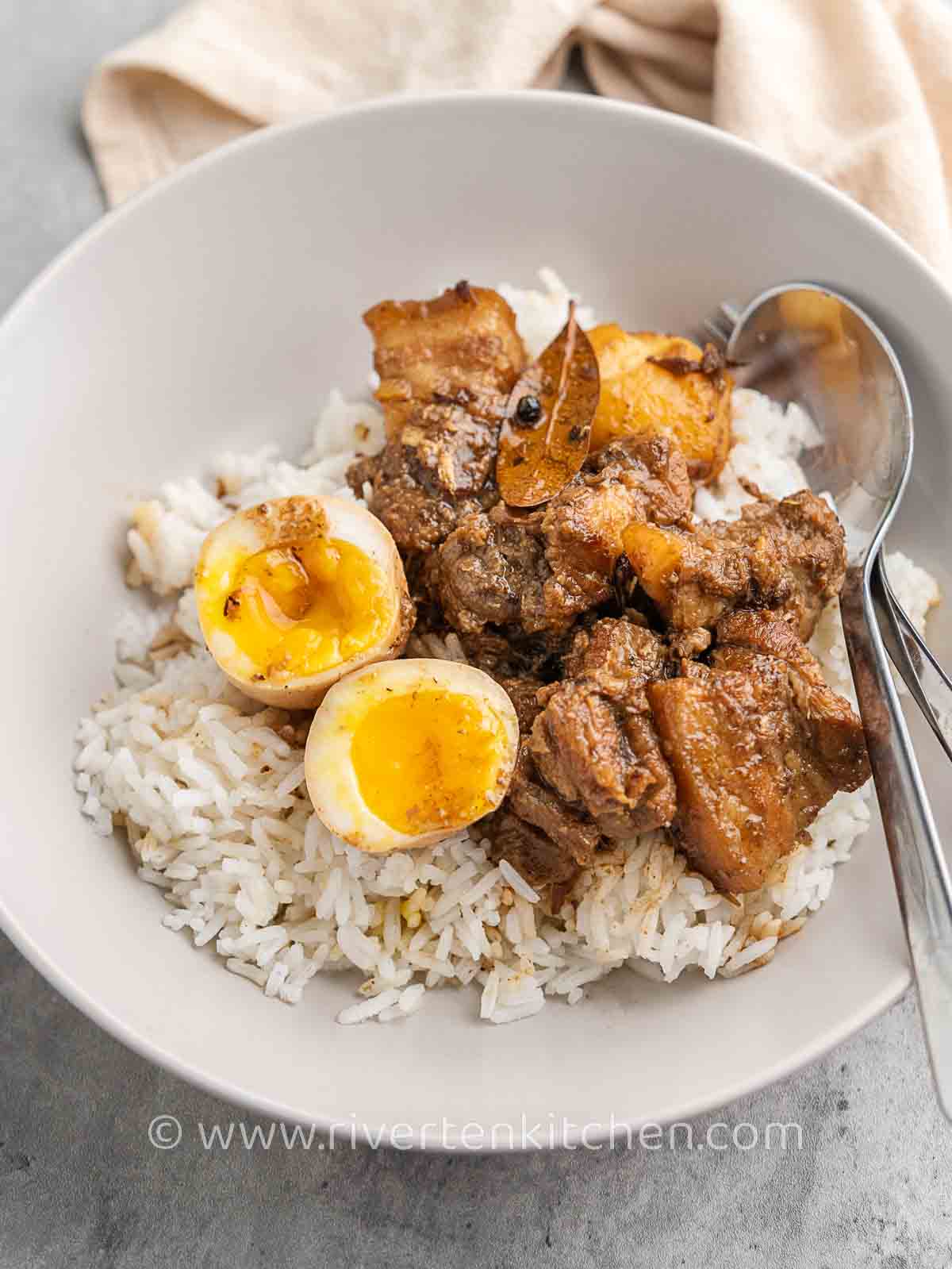
Variations
- Sweet adobo – just add more sugar! Use white or brown.
- Spicy Adobo – add red-eye chili to make it hot and spicy or green chili to make it mildly spicy.
- Make it using chicken – try my easy chicken adobo recipe here. It’s so good!
Cooking Pork adobo in a Pressure Cooker or Instant Pot
Using a pressure cooker is one of the quickest ways to cook pork adobo. It’s not only time-saving but energy-saving too.
Here are my tips on how to make good pork adobo in a pressure cooker.
- Use pork ribs, pork belly, pork butt, and pork ham/legs. These cuts tenderize well in a pressure cooker with less chance of becoming stringy and rubbery.
- Use enough water but don’t fill it past the max level to prevent liquid from bursting out of the valve while releasing the pressure.
- Don’t include the potatoes in the pressure cooking process or they will disintegrate. Add them once the pork is tender and when you start reducing the liquid.
- Cooking time – thick cuts of pork belly with the size of 1 1/2 inch to 2 inches will require 20 minutes of cooking time. Pork ribs cut into one bone sections will require 25 minutes to 30 minutes of pressure cooking time.
Try my Pork Ribs Adobo Pressure Cooker Recipe!
Storage and shelf-life
Leftover pork adobo can last in the fridge for up to 1 week, stored in an air-tight container. To further extend the shelf life, freeze (without the eggs) in an airtight container or heavy-duty freezer bag. Thaw before reheating on the stove or microwave.
Hungry for more? Try these Filipino recipes
- Pork Binagoongan (Binagoongang Baboy)
- Filipino Menudo (no tomato sauce)
- Easy Chicken Afritada
- Pork Ribs Sinigang
- Easy Pork Belly Sisig
- Pork Embutido with Cheese
- Lechon Paksiw
- Pork Humba (Meltingly tender Pork!)
Watch How to Make It
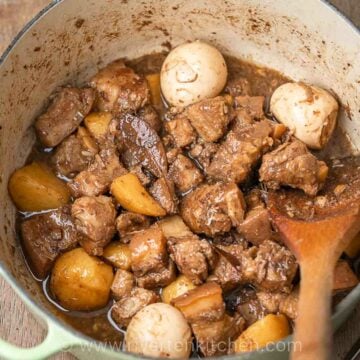
Pork Adobo Recipe (Twice Cooked)
Equipment
Ingredients
- 2 pounds pork belly, or pork butt/ shoulder (cut into chunks, note 1)
- 8 cloves garlic (finely chopped, divided)
- ⅓ cup vinegar (note 2)
- ⅓ cup soy sauce (note 3)
- 2 teaspoons brown sugar
- 1 cup water (add more if needed)
- 1 teaspoon black peppercorns
- 3 pieces bay leaf / laurel leaf
- 2 tablespoon vegetable oil
Optional but highly recommended
- 2 medium potatoes (note 4)
- 4 boiled eggs (note 5)
Instructions
1. Cook pork until tender
- Place pork, vinegar, and half of the chopped garlic in a pot. Turn on the heat and set it to medium-high. Bring to a simmer until the pork is no longer pink, around 5 minutes.
- Add soy sauce, brown sugar, water, black peppercorn, and bay leaf. Cover with a lid. Turn down the heat to medium-low and cook until the pork is tender. This could take 45 minutes to 1 hour depending on the size of the pork. If the liquid evaporates too quickly and the meat is still tough, just add more water.
- Separate the meat and sauce using a colander. Set aside.
2. Frying and thicken the sauce
- Heat vegetable oil in the now empty pot. Fry potatoes until the edges are brown. It doesn't need to be cooked through.
- Push potatoes to the side of the pot. Add garlic and stir-fry until lightly toasted. Be careful not to burn it or the sauce may become bitter-tasting.
- Add back the pork. Don't include the sauce yet. Fry for 2 to 3 minutes.
- Turn the heat to medium-high. Pour the adobo sauce all over the pork. Continue cooking until the sauce has thickened to your desired consistency and until the potatoes are cooked through. Do a taste test. Add sugar or a few teaspoons of soy sauce if preferred. I didn't need to add any to mine
- Add boiled eggs and gently toss until covered with the adobo sauce. Remove from heat. Serve with rice and enjoy!
Recipe Notes & Tips:
- Pork – I prefer using a combination of pork belly and pork shoulder/butt. Using pork with fat makes a richer and more flavorful sauce.
- Vinegar – I use white rice vinegar (not seasoned). Cane vinegar, coconut vinegar, and white wine vinegar work well too.
- Soy Sauce – I used Filipino soy sauce. If using regular soy sauce e.g. Kikkoman, use 1/3 cup plus 2 tablespoons.
- Potatoes – the starch in the potatoes helps further thicken the sauce. It also mellows down the saltiness and tanginess of the sauce.
- Eggs – Use soft-boiled eggs or hard-boiled eggs.
- Cooking Time – to reduce cooking time, slice pork and potatoes into small chunks about 1/2 inch.
- Nutrition – Pork belly cut is used in the calculation. Calories should be lower if using pork butt or shoulder. Potatoes and eggs are also included in the calculation.
- Sweet Adobo. Just add more sugar! Use white or brown.
- Spicy Adobo. Add red-eye chili to make it hot and spicy or green chili to make it mildly spicy.
Originally published August 2019. Updated with new photos, video, and a streamlined recipe after further testing.
Riverten Kitchen is a participant in the Amazon Services LLC Associates Program, an affiliate advertising program designed to provide a means for sites to earn advertising fees by advertising and linking to amazon.com

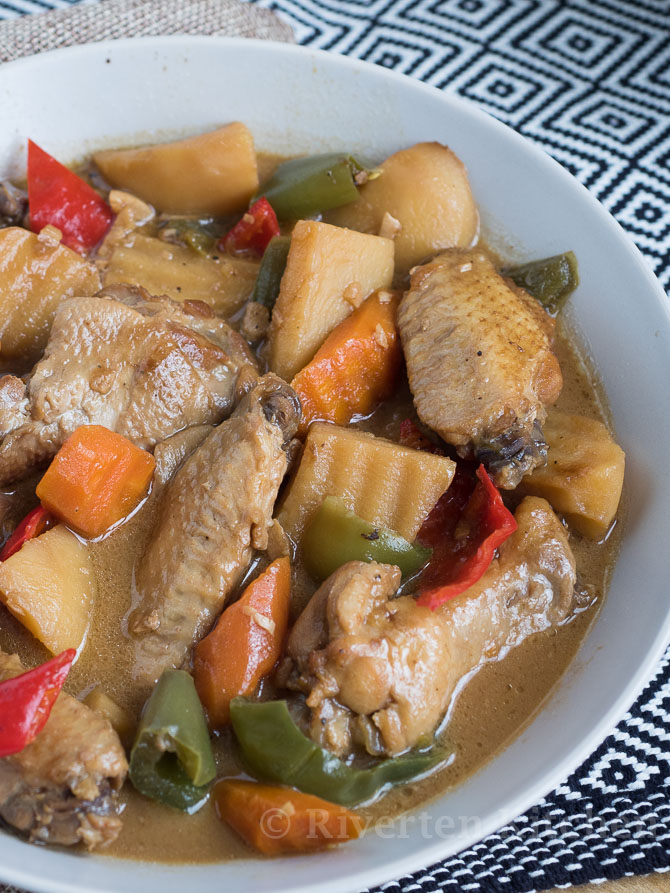
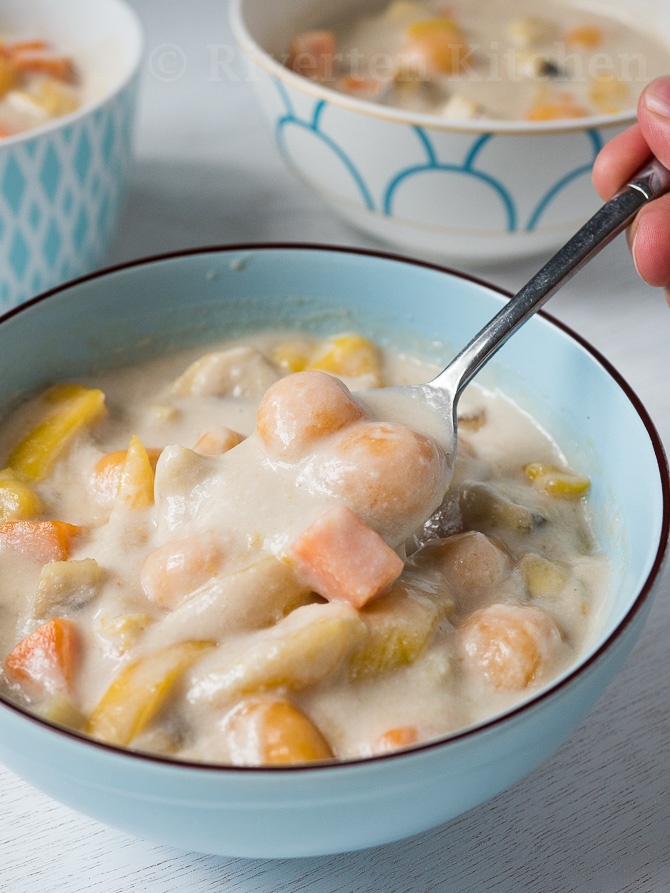
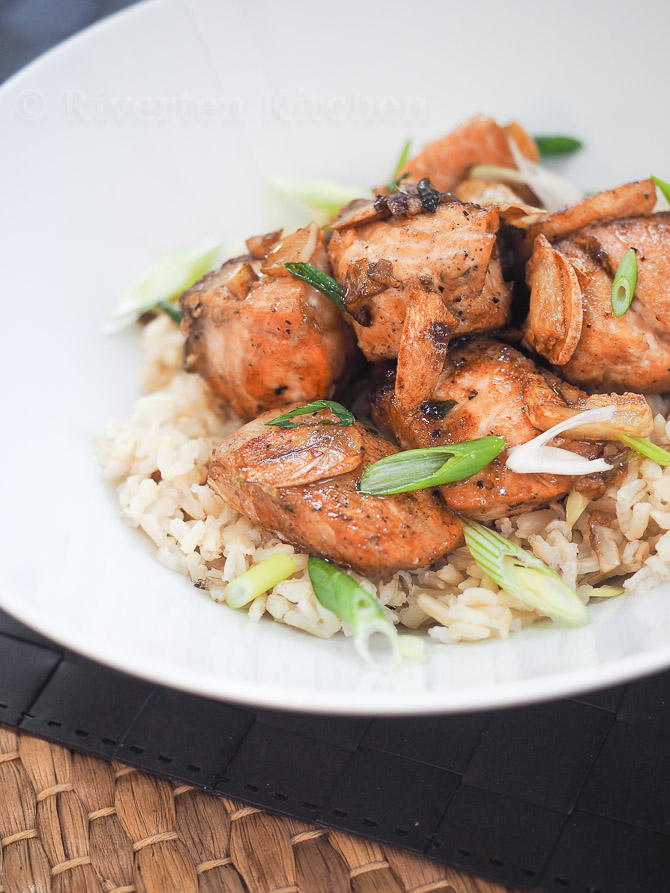

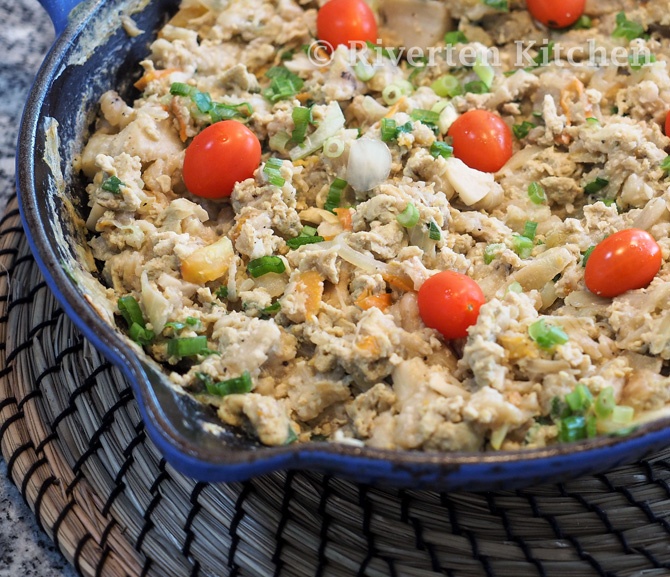
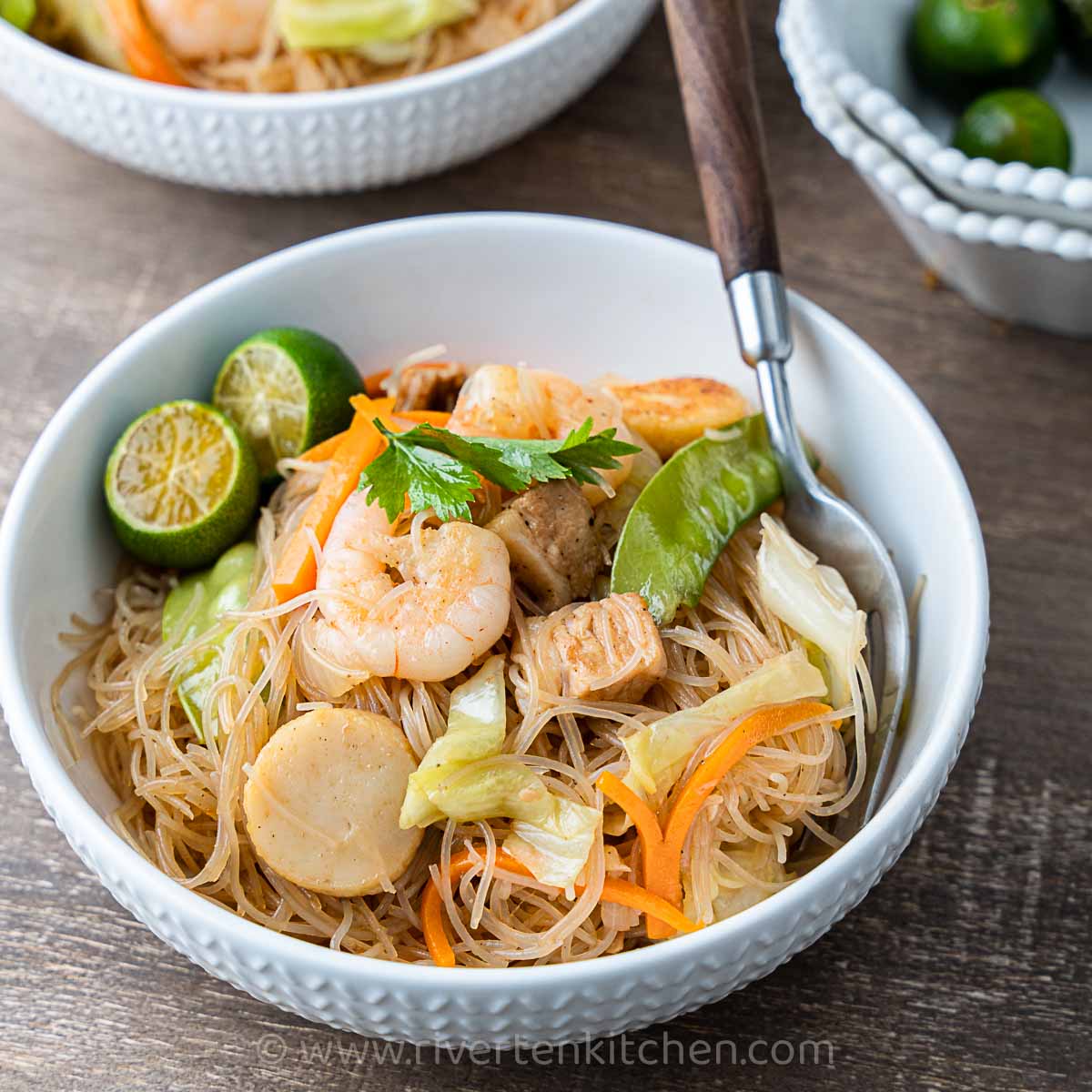
I love this version of adobo! Same with your beef caldereta, pork menudo, karekare, and ensaymada!! Thumbs up from me and the entire fam! I will definitely try more of your recipes! Great job!
Wow, that means the world to me! It’s always rewarding when people connect with my food. Thank you for your kind words and encouragement. I hope you do try more recipes, and please let me know if you have any questions.
– ❤️ Mella
So delicious and comforting! Thank you for sharing your recipe:)
Glad you enjoyed my adobo recipe, Ranae! Thanks for the wonderful feedback.
– Mella
This is my go-to adobo recipe! So happy I chanced upon this recipe last year. Been making it everytime we get a craving. So easy to make, so tasty and filling! We also use the leftovers for adobo sandwiches! Perfect in pandesal with butter, tomato slices, salt and pepper! Yum!